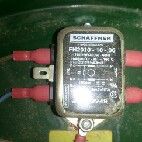Posted by Ajohnw on 07/01/2017 13:49:14:
 I didn't want to mention don't have to be used on here. It's a bit like PAT testing there are variables. I do wonder why an industrial plug though. Suggests there is something wrong with what we usually use. I would also wonder if fixed wiring regs were different to plugs.
I didn't want to mention don't have to be used on here. It's a bit like PAT testing there are variables. I do wonder why an industrial plug though. Suggests there is something wrong with what we usually use. I would also wonder if fixed wiring regs were different to plugs.
…….
The latest addition is bugging me. 10mm^2 bonding on gas pipes just past the meter. If you have one of the people in who can work on the supply side of things they have to leave a card saying this should be done. There are also some cowboys about leaving card saying must do it now. The person who left one here was apologetic about it and shook his head when he told me about the 10mm^2. He said he has to leave them just about everywhere he goes.
……
Anyway leaves me wondering why regs don't state test it and fix if needed as far as bonding is concerned.
John
I don't think omitting an RCD is quite like pat testing. Pat testing is there to ensure that something isn't damaged or faulty and unsafe. ie works as designed. It is hard to argue that is not a good idea.
Whether you have an RCD or not is a design issue. There are some circumstances where they are not a good idea as they will cause problems. eg machine tools with out of phase currents, medical equipment where an interrupted supply could cause harm, etc.
Hence the regs say RCDs should be used on socket outlets not exceeding 20A and mobile equipment used outdoors with a current rating of less than 32A. The point being that both of these are higher risk, either because you cannot control their use (eg sockets) or because of the environment (outdoors). For lower risk stuff the need for RCDs is not so important.
In fact there is also a exception – for a specific socket that is for use for a particular item of equipment and labelled as such. So I have one socket in my garage/workshop that is not RCD protected. It is specifically for my door entry system because I would really like to be able to get in, even if a bit of water gets in the electrics 
So if someone had a machine that was not faulty but still caused RCD problems I would have no problem fitting a non RCD outlet for it. I would of course want to make sure the machine was wired in such a way there was no chance of cable damage or other accidental access to a live part and that the machine was properly earthed.
Bonding is a real can of worms! This is one area where it should be sorted even it was ok against the regs when installed. Hence the gas man giving everyone leaflets saying it must be done. In fact the 10mm2 min is actually for PME/TNC, for TNCS or TT it can sometimes be 6mm2.
Like I say, it is a real can or worms and can actually cause a hazard – I have seen a video of a gas pipe smoking due to a PME system fault being earthed through the bonding! However in general it can save lives if there is a fault somewhere outside the property and can be essential in ensuring an RCD works properly for an internal fault.
EDIT: forgot to say, the guidlines DO say test and fix for bonding. Strictly no work should be done unless bonding is present and measures less than 0.05 ohms, but it doesn't necessarily need to upgraded to 10mm2 if it appears ok.
Toby
Edited By Toby on 07/01/2017 17:41:17
Toby.







